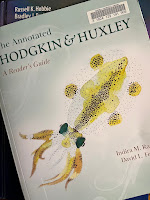 |
| The Annotated Hodgkin & Huxley, by Indira Raman and David Ferster. |
After nearly seventy years, Alan Hodgkin and Andrew Huxley’s 1952 papers on the mechanisms underlying the action potential seem more and more like the Shakespeare plays of neurophysiology, works of astounding beauty that become less accessible to each successive generation of scientists. Everyone knows the basic plot (the squid dies at the beginning), but with their upside-down and backwards graphs and records, unfamiliar terminology and techniques, now arcane scientific asides, and complex mathematical underpinnings, the papers become a major effort to read closely without guidance. It is our goal to provide such guidance, by translating graphs and terminology into the modern idiom, explaining the methods and underlying theory, and providing historical perspective on the events that led up to the experiments described. By doing so, we hope to bring the pleasure of reading these extraordinary papers to any physiologist inclined to read them.Raman and Ferster then give seven reasons to be so inclined.
- “The sheer pleasure of an exciting scientific saga...”
- “Coming to know the electrical principles that govern the operation of neurons...”
- “To see firsthand what it is like to be at a scientific frontier...”
- “The series of papers provide an exemplary…illustration of the scientific method at its best...”
- “To understand the purpose and power of quantification and computation in science...”
- “The papers teach us that rigorous science does not require the elimination of error and artifact,”
- “To develop a sense of one’s place in history.”
After a brief chapter about the historical background, the fun really begins. Each of the five papers is presented verbatim on even-numbered pages, with annotations (notes, redrawn figures, explanations, comments) on facing odd-numbered pages.
One annoying problem with the original papers is that Hodgkin and Huxley defined the transmembrane potential differently than everyone else; they took resting potential to be zero and denote depolarization as negative. Raman and Ferster have redrawn all the figures using the modern definition; rest is −65 mV and depolarization is positive. With this change, the plots of the m, h, and n gates (which control the opening and closing of the sodium and potassium channels) versus transmembrane potential look the same as they do in Fig. 6.37 of Intermediate Physics for Medicine and Biology. I sometimes wish I could take a time machine, go back to 1952, and say “Hey Al! Hey Andy! Don’t use that silly convention for specifying the transmembrane potential. It will be a blemish your otherwise flawless series of papers.”
One of my favorite annotations is in response to Hodgkin and Huxley’s sentence “the equations derived in Part II of this paper [the fifth article in the series] predict with fair accuracy many of the electrical properties of the squid giant axon.” Raman and Ferster write “This may be the greatest understatement of the entire series of five papers.” I would say it’s one of the greatest understatements in all of science.
The final annotation follows Hodgkin and Huxley’s final sentence of their fifth paper: “it is concluded that the responses of an isolated giant axon of Loligo to electrical stimuli are due to reversible alterations in sodium and potassium permeability arising from changes in membrane potential.” Raman and Ferster add “H&H end their tour de force with a mild but precise statement that electrical excitability in the squid giant axon results from voltage-gated conductances. The discoveries that underlie this simple conclusion, however, completely transformed the understanding of cellular excitability in particular and bioelectricity in general. As John W. Moore—a postdoc with Kenneth Cole in 1952—once quipped, it took the rest of the field about a decade to catch up.”
The appendices at the end of The Annotated Hodgkin & Huxley are useful, particularly Appendix Five about numerical methods for solving the Hodgkin & Huxley equations. Huxley performed his calculations on a mechanical calculator. Raman and Ferster write
The mechanical calculator Huxley used was a pre-war era Brunsviga Model 20… which is an adding machine with a few features that streamline the calculations. To multiply 1234 by 5678, for example, one must follow these steps:
- Enter 1234 on the sliding levers (on the machine’s curved face), one digit at a time.
- Position the carriage (at the front of the machine) in the ones position.
- Turn the crank eight (at the far right) times.
- Slide the carriage to the tens position
- Turn the crank seven times.
- Slide the carriage to the hundreds position.
- Turn the crank six times.
- Slide the carriage to the thousands position.
- Turn the crank five times.
Thus, 30 individual operations are required to multiply two four-digit numbers.
Andrew Huxley, you are my hero.
Happy 70th anniversary of the publication of these landmark papers. I’ll end with a quote about them from Raman and Ferster’s epilogue
The following decades saw tremendous advances in physiology that built directly on the discoveries of H&H. Ultimately, what began as a basic scientific inquiry in a fragile invertebrate with a fortuitously oversized axon would provide the basis for the development of a vast array of biomedical research fields. The studies that the H&H papers made possible would not only yield immeasurable insights into brain and muscle function but also identify, explain, and alleviate medical conditions as diverse as epilepsies, ataxias, myotonias, arrhythmias, and pain.



No comments:
Post a Comment